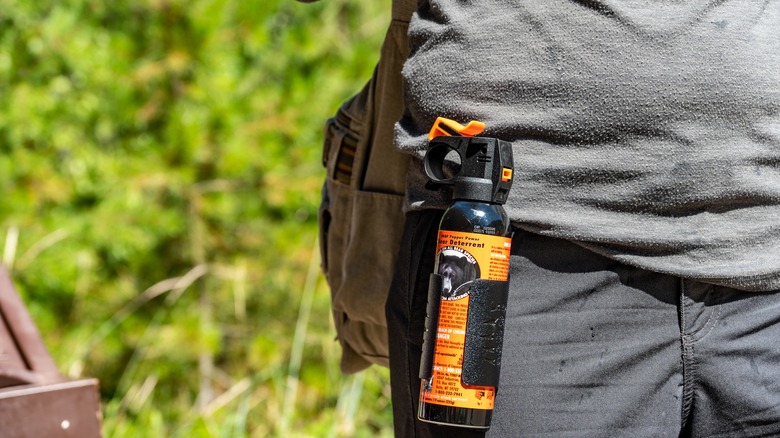Why You Should Pack Bear Spray Even If You Aren't Hiking In Bear Country
With bear attacks on the rise, hikers are advised to carry bear spray and know how to use it whenever they are adventuring in bear territory. Given that black bears are found in every province in Canada, with the exception of Prince Edward Island, and in four-fifths of the states in the U.S., odds are many of these outdoor excursions will actually be in bear territory. However, there are good reasons why you should pack bear spray even if you aren't hiking in bear country.
While bears are perhaps the most notorious of creatures that can cause harm to hikers, there are a number of other animals that potentially pose a risk. Bison are one of the most dangerous animals you can encounter. Mountain lions have been known to attack people. Majestic animals such as moose can pose a threat. Even small animals can be dangerous when encountered on a hike. Bear spray is an effective deterrent against these and other animals that attempt to attack.
It is important to note, bear spray should only be used as a last resort. Essentially, it should only be employed while an animal is actively attacking. It is also worth mentioning that bear spray is not lethal. It relies on the irritating properties of red pepper oil to cause inflammation in the animal's respiratory system and burning sensation in their eyes and other sensitive areas. This effect is temporary. It is designed to give you time to escape, not cause permanent harm to the animal. However, in order for bear spray to be effective as a deterrent, it is important to know how to use it properly.
How to use bear spray for protection while hiking
One of the first things to be noted about bear spray is there are not the same restrictions on the purchase of it or possession of it as are placed on firearms. But, while it is not restricted nor lethal, it is still dangerous and should be handled properly and with caution. Again, it is considered a measure of last resort, but should that time come, you need to know how to properly utilize it for your protection. To that end, it is a good idea to practice with bear spray before heading into the field.
The Alaska Department of Fish and Game advises that when it is time to hit the trail, you detach any straps or ties that are designed to lock the device. This allows you to quickly deploy it when necessary. When hiking, you should carry the spray holstered or clipped in a secure spot that can be reached easily and quickly. It should be unclipped and at the ready when an animal begins showing signs of aggression.
If an animal is charging to attack, hold the canister firmly, chest high, remove the safety clip, and squeeze the trigger to discharge a short, two-second burst. Keep in mind, most bear sprays such as the SABRE Frontiersman have a range of 30 feet. The spray is expelled not as a pinpoint stream, but rather as a cone-shaped cloud. The idea is to create a barrier beyond which the animal will not continue. If the first burst was not effective to stop the animal's charge, spray a second burst as it gets closer. Once the incident is over, leave the area, but do so slowly while keeping an eye on the animal.

